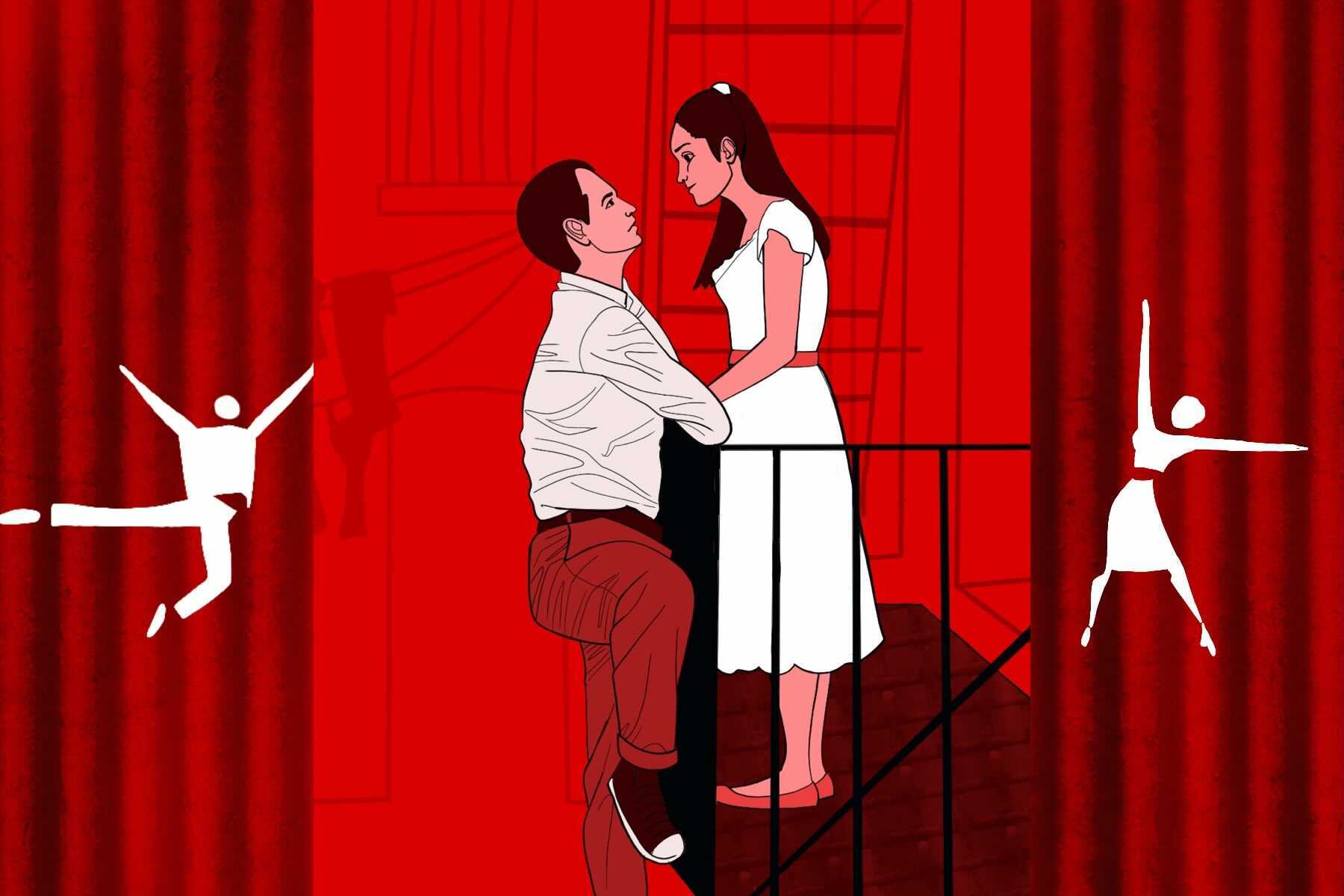“West Side Story,” based on Shakespeare’s “Romeo and Juliet,” combines the romanticism of first love with the tragedy of dying young against the gritty backdrop of 1950s New York. Originally based off of a novel by Arthur Laurents, it has been staged on Broadway thousands of times and immortalized in film by Robert Wise and Jerome Robbins. When Steven Spielberg signed on to remake the film in 2018, he knew he had quite a legacy to live up to. By taking advantage of a rich screenplay and paying close attention to detail, he was able to offer a fresh take on an old classic.
20th Century Studios originally planned to release “West Side Story” in 2020. However, the studio delayed the date for one year due to the COVID-19 pandemic and released it exclusively in theaters in December 2021. Though the film underperformed at the box office in its opening weekend, it has received acclaim from critics for pushing the boundaries of the original film and reestablishing the story’s relevance in the 21st century.
By casting Puerto Rican and Latino actors and actresses, Spielberg respects the cultural roots of the Sharks and expands the horizons of representation in mainstream film. Some actors are just getting their start here: Rachel Zegler, who plays Maria, answered the casting call at age 17 and is now starring in one of the biggest films of the year.
Spielberg also brought back some familiar faces, too. Rita Moreno, who won an Oscar for playing Anita in the 1961 film, plays a new character, Valentina, and also serves as an executive producer on the project. It’s refreshing to see Moreno in a position of authority, especially given the brown-face controversy on the set of the original film and Moreno’s decades-long struggle to seek out and play non-stereotypical Latina roles. She showcases her comedic, musical and dramatic range in Spielberg’s remake, doing justice to a role written specifically for her.
Moreno’s character also contributes to the film’s more nuanced portrayal of interracial romance. Valentina, in a black-and-white photo, stands hand-in-hand with her husband Doc, a white man. In the wake of his untimely death, she continues to run the convenience store that they founded on the West Side.
Though she reflects lovingly on their successful marriage, she tells Tony that the racial tensions around their marriage never completely subsided, noting that she never became a “gringo” by marrying one. This adds layers to the central romance between Tony and Maria, exploring the limits of love and family in broaching racial divisiveness.
Some of the biggest differences come in the form of deeper characterization and reinterpretation of individual characters. In Tony Kushner’s new screenplay, Riff is given more of a backstory, and Mike Faist — the actor who plays Riff — completely inhabits the part. In preparation for the role, Faist lost weight and took boxing classes to more accurately portray the rough-and-tough nature of his character.
It pays off, as he brings complexity, rawness and a wisecracking vulnerability to what was originally an impenetrable, two-dimensional character. In a tense scene, a man points a gun at Riff’s head; in response, Riff leans in and stares down the barrel, daring him to do it. Faist improvised the moment, an enlightened character choice that highlighted the way Riff lived and died: trying to prove something.
Kushner also fleshed out Anita’s character, giving her more room to be her own person. Ariana DeBose portrays Anita’s intelligence and independence wonderfully, drawing the audience in through her magnetic screen presence when she both acts and dances. DeBose’s liveliness and passion come through when Anita discusses her dream of becoming her own boss and starting a sewing business.
Anita also shines in more serious scenes, such as when she shoots down Bernardo’s dream of having six children, refusing “to put six children to bed hungry.” It explains the root of Anita’s hopes in “America” and builds her up into a more three-dimensional character.
Rachel Zegler’s and Ansel Elgort’s portrayals of Maria and Tony are more of a mixed bag. Rachel Zegler delivers a satisfying performance, showcasing her versatility in being able to dance, act and sing. (This wasn’t the case with Natalie Wood, who played Maria in the 1961 film; her singing voice was dubbed over by Marni Nixon.) Unfortunately, Ansel Elgort delivers an underwhelming performance opposite Zegler. Though he is obviously passionate about the role, having played it before in a school production, that conviction just doesn’t translate to screen.
Some of it may have to do with the subtle changes Kushner made to Tony’s backstory. In the original 1961 film, Richard Beymer portrayed Tony with a certain type of innocence: His idealism set him apart from the other Jets, who became cynical as products of their environment. In the 2021 film, Tony has served a year in prison for assault and has just been released. He is more experienced and cautious, afraid of himself and what he is capable of. Though Elgort is wholly believable as a love interest and peacemaker, he just doesn’t have the edge needed to come off as dangerous or rebellious.
Where Tony’s new background does succeed is in recontextualizing violence within the narrative. Originally, when Tony stabbed Bernardo, he came off like a deer in headlights, completely appalled by what he had done and at a loss for what to do next. In the remake, Tony stabs Bernardo in a fit of rage and then grimly accepts that his worst fear has come to pass: He has given in to his darker impulses.
In the original film, Bernardo and Riff’s deaths served as catalysts for the Jets to grow up and realize the consequences of their actions. In the new film, their deaths also carry personal significance. Though Tony was supposed to know better, he still ended up perpetuating the cycle of violence that plagues the West Side.
Steven Spielberg taps into these poignant moments in “West Side Story” through subtle visual cues that evolve throughout the film. He succeeds in visual reinterpretation by realizing the genius is in the details, honoring the story told in terms of historical accuracy and artistic integrity.
For example, Spielberg creates a delicate rainbow motif that stretches across the film. In a scene where Tony and Maria confess their love for one another, stained glass from the cathedral’s windows shines down in facets of rainbow color; the windows of apartment buildings on the West Side are lit up in different colors, and even the sheets Bernardo and Anita kiss through add splashes of bright color to an otherwise plain backdrop. It makes the first half of the film more exciting and sets the stage for the darker, more moody aesthetics in the second half of the film.
Spielberg also altered the location and staging of dance numbers. Originally, Ice and the rest of the Jets performed “Cool” after Riff was stabbed to death; in the new version, Tony and Riff perform “Cool” before the rumble. Turning the choreography for the song into a fight over a gun was a clever storytelling technique. It says something about each character’s relationship with violence while also symbolizing the fight for peace between the rival gangs on a wider level. Tony and Riff swing and jump over holes in the concrete, highlighting the subtle current of passive-aggression that “Cool” always carried but never truly capitalized on until now.
However, a couple of dance numbers should have been left for more intimate settings. It is clear that the film has a higher production value, and Spielberg takes full advantage of that by incorporating large crowds into ensemble dance numbers. This becomes most apparent in the new version of “America,” which was originally performed as a casual, impromptu dance-off with the Puerto Rican men and women lined up on either side and trading friendly jabs in the middle.
In this version, it’s blown up into a full dance breakdown, grouping together the whole town in the middle of the street. Despite its lower production values, the original film had a very grounded center to it, honing in on moments of charming intimacy and more insular, sinister scenes. Spielberg’s reinterpretation sometimes falls short in accomplishing the same level of immersion.
Perhaps the strongest element of Spielberg’s remake is in doing some more world-building to make up for the lack of intimacy. Though Spielberg is often derided by critics for being overly sentimental — sometimes to the point of sanitizing prickly narratives — he avoids that in “West Side Story” by setting the gangs’ fight against the backdrop of gentrification in 1950s New York. The gangs fight in desolate construction yards and salt sheds as their home — at least as they all know it — falls down around them.
Tragically, no one in the story actually owns the turf that they are fighting to get back; it’s really the establishment that owns the land and decides what to do with it. The blue-collar Jets and Sharks fight one another as their home is gradually taken away from them, a problem that realistically goes unsolved by the end of the film.
In reinterpreting “West Side Story” for new audiences, Spielberg avoided gentrifying a complex story with a fraught history attached to it. He honored it, restored it and found ways to mine new pockets of authenticity by understanding the story’s significance in the larger culture. There are just some films that will never go out of style, and this is one of them.

















